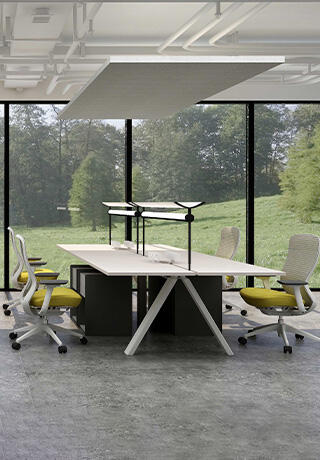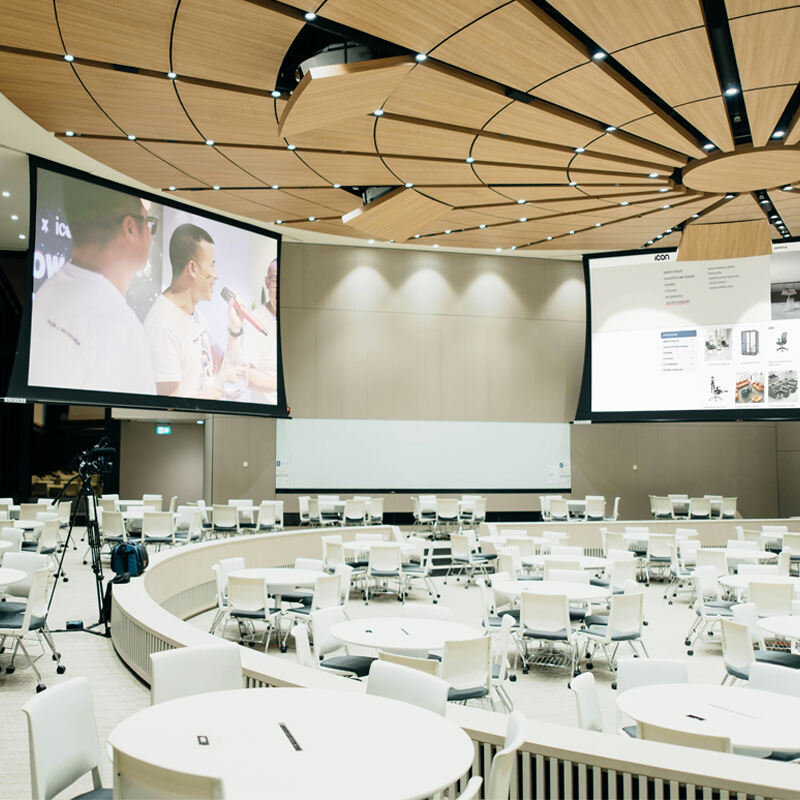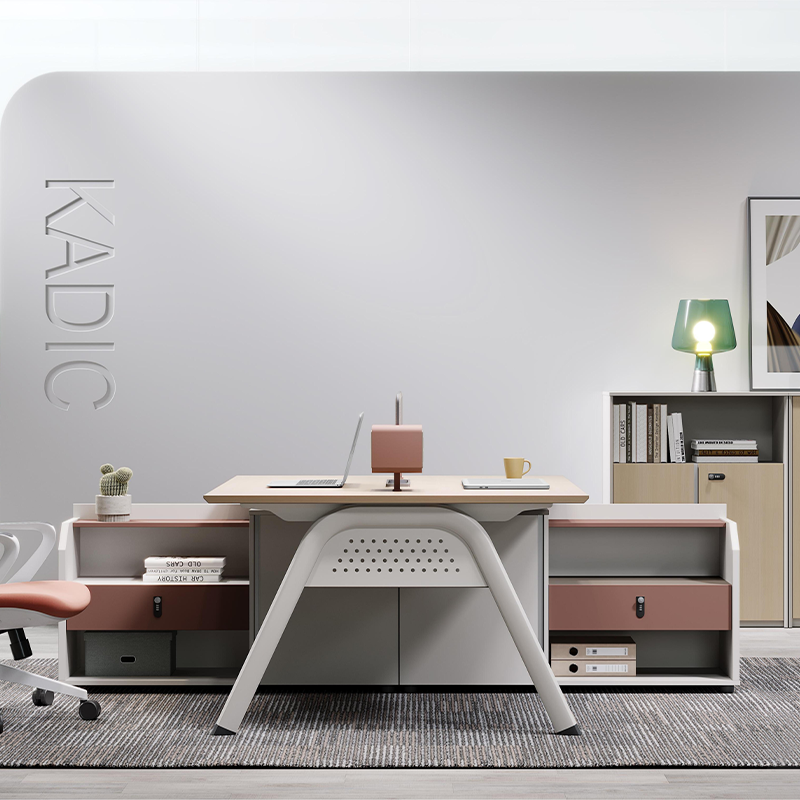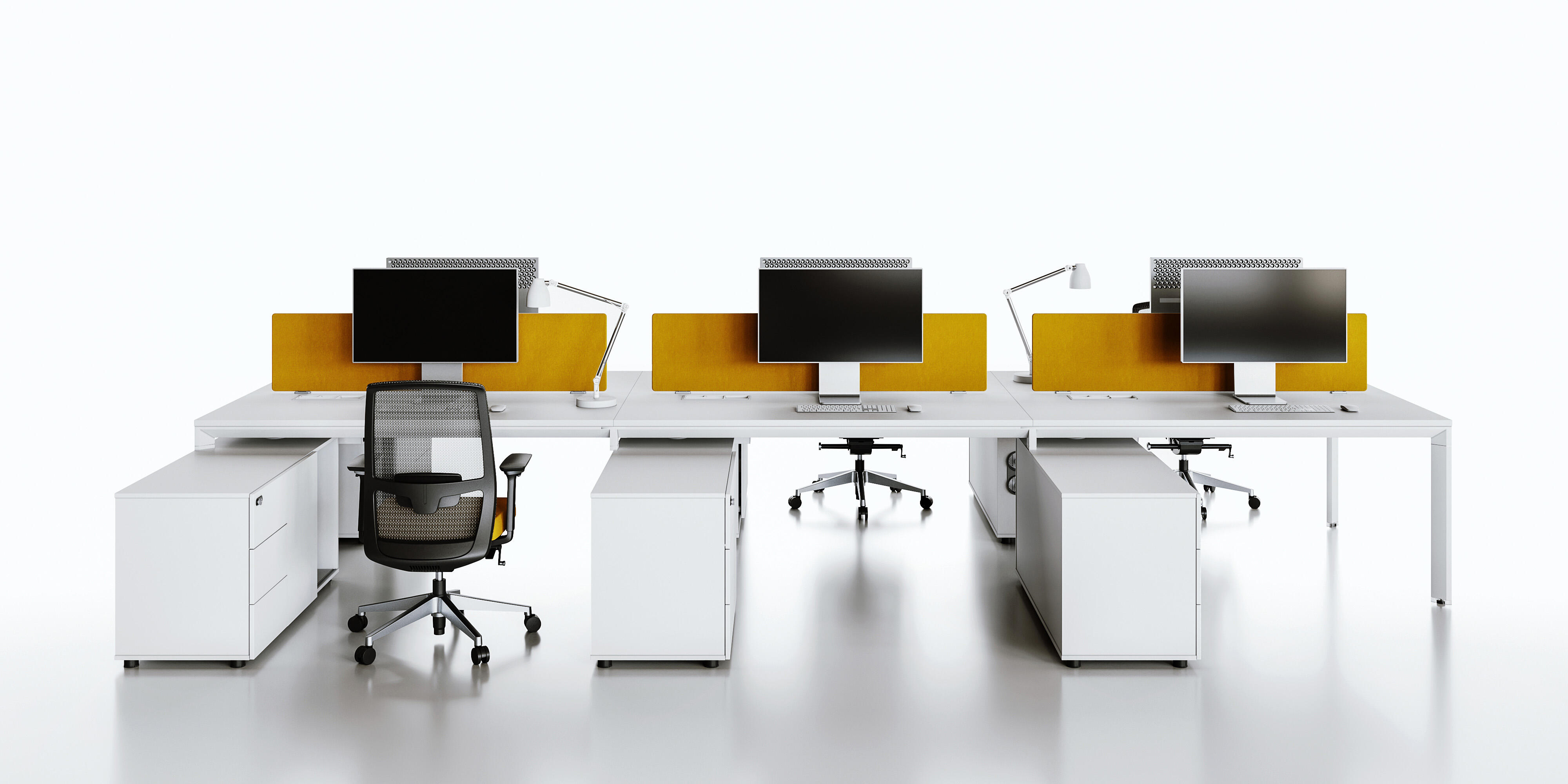ایستگاههای کاری ماژولار به عنوان مبدلهای پویای فضا
پیکربندی فضای کاری چابک در دفترهای هیبریدی
مدل اسیستهای کاری مشکل اصلی دفترهای هیبریدی را حل کنید: چگونه از کار تیمی و کار انفرادی به طور همزمان پشتیبانی کنیم. مدرن اسیستهای کاری میزهای قابل تنظیم ارتفاع را با صفحات حریم خصوصی چرخدار همراه کنید که به راحتی فضاهای کاری فردی را به فضاهای اجتماعی تبدیل میکنند. یک مطالعه انجام شده در سال 2024 از محیط کار نشان داد که در دفترهایی که از اجزای ماژولار استفاده میکنند، 62 درصد سریعتر از دیگران تیمها دوباره سازماندهی میشوند، که برای شرکتهایی که بین کارهای تخصصی و پروژههای بینرشتهای حرکت میکنند، امری حیاتی است.
ستونهای توزیع برق متحرک و ایستگاههای داکینگ بدون ابزار به کارمندان این امکان را میدهند تا هر فضای کاری را به عنوان مخصوص خود در نظر بگیرند و ذهنیت «مالکیت میز» که در انتقالهای هیبریدی مشکلساز است را از میان ببرند. این انعطافپذیری مستقیماً با افزایش ۴۱٪ای در نرخ استفاده از فضا در بازرسیهای سهماهه نسبت به محوطههای متداول اداری همراه است.
تغییرات آنی در طراحی فضا برای مقیاسپذیری تیم
استلند/برایتون راستیکیشن، توسط شرکت ویلیام راون اسوئیتس. زمانی مقیاس واقعی حاصل میشود که سیستمهای مبتنی بر اجزا بر اساس زمان سازمانی و نه زمان ساخت تعیین شوند. تیمهای پروژهای با ظرفیت متغیر از خوشههای ایستگاه کاری قابل تنظیم استفاده میکنند که از گروههای چهارنفره به اتاقهای جنگی بیستنفره با استفاده از سیستمهای اتصال استاندارد توسعه مییابند. بлагداد صفحات صوتی مغناطیسی و قطعات نصبی بدون ابزار، کارمندان خدماتی میتوانند تغییرات عمده در طرحبندی فضا را در طول استراحت ناهار و نه فقط در آخر هفته انجام دهند.
تولیدکنندگان پیشرو در حال حاضر سنسورهای اینترنت اشیا (IoT) را در قابهای ماژولار ادغام میکنند تا آنالیز فضای در زمان واقعی را فراهم کنند. حداقل یکی از رویکردهای پیادهسازی چنین جریان دادهای، امکان قرارگیری ایستگاههای کاری را مطابق الگوهای استفاده واقعی فراهم میکند – دور از تخصیص فضای بر اساس مترمربع و بیشتر مبتنی بر معیارهای استفاده فعالیت محور. در آزمایشهای انجام شده در سه ماهه اول سال 2024، پیشگامان با تغییر ماژولار هوشمندانه تأسیسات خود، موجودی فضاهای خالی را کاهش دادند و ظرفیت اوج را حفظ کردند – به طوری که 28٪ کمتر فضای کاری بدون استفاده داشتند.
صرفهجویی در هزینه با استفاده از سیستمهای مبلمان ماژولار
اجزای قابل تنظیم مجدد در مقابل چرخه تعویض مبلمان سنتی
سیستمهای ماژولار این چرخه 5 تا 7 ساله تعویض مبلمان را میشکنند و امکان ارتقاء گامبهگام را فراهم میکنند. به جای اینکه یک میز را به عنوان یک واحد ثابت در نظر گرفت که در هنگام بازسازیهای دورهای دفتر باید همراه با بقیه فضا تغییر کند، شما میتوانید اجزای حجیمی که 40 تا 60 درصد ارزش عمر مفید زیرساختهای فناوری را دارند، جایگزین کنید. با استفاده از پنلها و لوازم جانبی قابل تعویض، یک ایستگاه کاری Artopex میتواند 8 تا 10 طرح مختلف را پشتیبانی کند، در حالی که ایستگاههای کاری سنتی نیازمند تخریب کامل هستند وقتی تیمها باید گسترش یابند یا جریان کارها دوباره تنظیم شود. این انعطافپذیری عمر مبلمان را به 12 تا 15 سال افزایش میدهد و هزینههای دفع و زمان بیکاری از دسترسی به مبلمان را کاهش میدهد.
محاسبات بازگشت سرمایه استفاده از فضا (شاخصهای IFMA 2024)
دادههای جدید IFMA نشان میدهد که پیکربندیهای ماژولار با استفاده از دیوارهای قابل تاشو و مناطق کاری جاساز، کارایی فضا را نسبت به طرحهای ثابت ۳۰٪ افزایش میدهند. برای یک دفتر ۱۰۰ نفره، این موضوع به معنی صرفهجویی سالانه ۲۸۴ هزار دلاری در هزینههای املاک است که از طریق کاهش متراژ مورد نیاز به دست میآید. اکنون در محاسبات ROI عوامل زیر نیز در نظر گرفته میشوند:
- زمانهای تنظیم مجدد ۵۸٪ سریعتر (۲/۱ روز در مقابل ۵ روز برای تنظیمات سنتی)
- چگالی کارکنان ۱۹٪ بالاتر بدون قربانی کردن راحتی
- نرخ استفاده مجدد ۸۷٪ از اجزای اصلی در هنگام انتقال دفتر
این معیارها سیستمهای ماژولار را حتی برای استارتآپهای کوچک نیز از نظر مالی مقرون به صرفه میکند، به طوری که نقطه سربهسر به طور متوسط ۱۸ ماه زودتر از سرمایهگذاریهای معمولی در تجهیزات اتفاق میافتد.
ادغام ارگونومیک در ایستگاههای کاری ماژولار
استانداردهای ادغام میز کار قابل تنظیم ارتفاع
وسایل نوین و ماژولار با تمرکز بر انعطافپذیری بیومکانیکی، اکنون 82 درصد از کسبوکارها را به ارائه میزهای قابل تنظیم ارتفاع به عنوان زیرساخت اصلی محیط کاری واداشته است (IFMA 2023). این سیستمها با استانداردهای ارگونومیک ANSI/BIFMA G1-2020 سازگار هستند و میتوانند انتقال را بین حالت نشسته و ایستاده به راحتی ایجاد کنند و 27٪ از شکایات اسکلتی-عضلانی را نسبت به میزهای ثابت سنتی کاهش دهند. شرکتهای پیشرو فناوری پس از اجرای ایستگاههای کاری کاملاً قابل تنظیم بر اساس معیارهای آموزشی استاندارد شده و آموزش وضعیتهای پویای حمایتی برای تمامی قدهای کارکنان (از 5 درصد زنان تا 95 درصد مردان) 41٪ کاهش در آسیبهای ناشی از استرس تکراری را تجربه کردهاند.

ماژولهای حمایت از وضعیت بدنی بر اساس وظیفه
تا سال ۲۰۱۸، اجزای اختصاصی برای وظایف خاص طراحی شده بودند تا نیازهای فیزیکی را پوشش دهند: جعبههای صندلی کیبورد معلق برای برنامهنویسان، بازوی نگهدارنده مانیتور قابل تنظیم برای طراحان، صندلیهای کاری قابل تنظیم برای تیمهای همکاری. در یک مطالعه در سال ۲۰۲۲ در دانشگاه کورنل، محققان دریافتند که استقرارهای اختصاصی ماژولار، به دلیل زاویههای بهتر نمایش صفحه نمایش، باعث کاهش ۳۳ درصدی موارد درد در ناحیه پشت بالایی در مراکز تماس شده است. پشتیبانهای قابل تعویض کمر، پایههای پا و پد استراحتگاه دست که کارکنان میتوانند با راهنماییهای QR کد ساده به خودی خود تنظیم کنند، اکنون توسط تولیدکنندگان عرضه میشوند.
متمرکز بر سلامت محیط کاری روند گواهیها (WELL v2)
در حال حاضر، اینستیتوی ساختمان بهینه بینالمللی (IWBI) برای دریافت گواهی WELL نسخه 2، الزام به کاربرد مدولار بودن در راستای انطباق با استانداردهای ارگونومیک دارد و 48٪ از پروژههای جدید دفاتر تجاری از رویکرد قابل تنظیم و مدولار پشتیبانی میکنند (Gensler، 2023). طرحهای سازگار با WELL v2 شامل نورپردازی چرخهای، ارتفاع قابل تنظیم بدون اصطکاک، شفافیت مواد و همچنین قابلیت ساخت با اجزای مدولار هستند. پیشگامان این زمینه با ادغام پیشگیرانه این ویژگیهای بهداشتی در ماژولهای استاندارد میز کار، زمان تحویل گواهینامه خود را 19٪ کاهش دادهاند.
همکاری از طریق فلسفه طراحی مدولار
مهندسی تعاملات اتفاقی از طریق دیوارهای تقسیمکننده قابل حرکت
ایستگاههای کاری ماژولار با استفاده از دیوارهای متحرک و قطعات قابل تنظیم مجدد، فضاهای ملاقات غیر برنامهریزی شده ایجاد میکنند. دفتر کار در زمان واقعی و متناسب با نیاز تیم شکل میگیرد، بخاطر اینکه از پانلهای عایقبندی شده صوتی استفاده میشود که میتوانند چرخش کنند یا تا شوند و فضاهای کوچک گفتگو را شکل دهند. مطالعات نشان میدهند که فضاهای کاری با مرزهای پویا، به اشتراک گذاشتن ایدهها بین بخشها را 29٪ نسبت به محیطهای ثابت کارگاهی افزایش میدهند (شاخص نوآوری در محیط کار 2023). این فلسفه موانع فیزیکی ایجاد میکند که به عنوان عوامل تسریعکننده همکاری عمل میکنند - یک دیوار نیمهبلند به عنوان فضای ملاقات ایستاده عمل میکند، دیوارهای تخته سفید متحرک به راحتی حرکت داده میشوند و با نیازهای فرهنگ کاری تکامل مییابند.
مطالعه موردی: شتاب 37٪یی پروژه یک استارتآپ فناوری
یک شرکت نرمافزاری به عنوان سرویس (SaaS) ایستگاههای کاری ماژولار را با تحلیلگرهای هوشمند فضایی مبتنی بر هوش مصنوعی پیادهسازی کرد و بهبودهای قابل اندازهگیری در همکاری را به دست آورد:
- زمان تحویل پروژهها در طول شش ماه 37٪ کاهش یافت
- درگیریهای رزرو اتاقهای جلسه 52٪ کاهش یافت
- گزارش کارکنان از "برخوردهای بهرهور" هفتگی افزایش یافت
خوشههای میز همراه و نیمکتهای همکاری با ارتفاع قابل تنظیم این امکان را فراهم کردند که تیمها نه تنها بتوانند به سرعت از برنامهریزی اسکرام به دموی مشتری تغییر حالت دهند، بلکه بتوانند کارهای وابسته به پروژه را انجام دهند که میتوانست به سرعت در یکی یا هر سه آزمایشگاه تعیین دامنه شوند. نظرسنجیهای انجام شده پس از پیادهسازی نشان داد که ۶۸ درصد از کارکنان، بهتر شدن کارایی حل مسائل را به دلیل توانایی خود در بازآرایی فضای کار خود دانستند (گزارش تأثیر محل کار Q2 2024). این موضوع نشان میدهد که چگونه طرحهای ماژولار با هدف، تعادلی بین تعامل ساختاریافته و امکان تعامل «طبیعی» آزادتر را حفظ میکنند.
برتری زیستپذیری ماژولار کارگاهها
گردش ماده در قابهای قابل تفکیک
ایستگاههای کاری ماژولار با قابهایی که برای جمعآوری و مونتاژ مجدد مکرر طراحی شدهاند، به گردش مجدد مواد کمک میکنند. اقلامی مانند پروفیلهای آلومینیومی و اتصالدهندههای استاندارد شده بدین معناست که 87 درصد از کل مواد در طول چرخه حیات محصول مجدداً استفاده میشوند (گزارش اقتصاد دایرهای 2023)، در حالی که این رقم در قابهای فولادی جوشکاری شده در یک سیستم سنتی تنها 23 درصد است. این فلسفه طراحی این امکان را فراهم میکند که شرکتها تنها بخشهایی از ایستگاه کاری خود را مانند سطوح کاری یا ماژولهای نگهداری تعویض کنند، بدون اینکه مجبور باشند کل سیستمها را دور بریزند که این امر به تنهایی سالانه 34 درصد از پسماند فرسایشی مبلمان در محیطهای اداری را کاهش میدهد.
تحلیل چرخه حیات در مقایسه با مبلمان ثابت (گزارش Gensler 2023)
ارزیابی چرخه عمر در سال 2023 توسط شرکت Gensler نشان میدهد که سیستمهای ماژولار در طول 10 سال، 60٪ تأثیر محیطزیستی کمتری نسبت به مبلمان ثابت دارند. روشی جایگزین برای ایستگاههای کاری سنتی که در آن کل واحد هر 5 تا 7 سال یکبار تعویض میشود (مدل استقرار)، رویکرد ماژولار است که عمر ایستگاه کاری را با بهروزرسانیهای دورهای افزایش میدهد. یک چرخه تنظیم مجدد، 78٪ انرژی کمتری نسبت به تولید مبلمان جدید مصرف میکند. همان گزارش همچنین انتشار 11.2 تن کاهش کربنی را در هر 100 ایستگاه کاری در سال اعلام کرده است و اگر حتی پیگیریهای بیشتری برای دستیابی به صفر کربن انجام شود، حدود 740,000 دلار درآمد سرمایهای در هر دفتر متوسط ذخیره خواهد شد.
دفاتر آماده برای آینده با DNA ماژولار
نمونههای اولیه سازگاری فضای کار مبتنی بر هوش مصنوعی
مدلهای سازگار با فضای کاری مبتنی بر هوش مصنوعی در حال تغییر دادن نحوه سازگاری میزهای ماژولار با محیطهای کاری پویا هستند. این سیستمها از حسگرهای تعبیهشده برای ردیابی حرکت کارکنان، سطح همکاری تیمی و آمار بهرهوری فردی استفاده میکنند و سپس خوشههای میز و ارتفاع دیوارهای جداکننده را بهصورت آنی تنظیم میکنند تا جریان کار را بهینه کنند. یک مطالعه انجامشده در سال 2024 از اعضای فورچون 500 نشان داد که 68٪ از پیشگامان این حوزه چرخههای تصمیمگیری 19٪ کوتاهتری را با طرحهای هوشمند نسبت به طرحهای ثابت گزارش کردهاند.
در حال حاضر نمونههای اولیه پیشرفته ارگونومی سازگار را با سطوحی که بهصورت خودکار ارتفاع خود را بر اساس دادههای وضعیت بدنی کاربر تنظیم میکنند و مواد پاسخگو به شرایط آبوهوایی که راحتی حرارتی را تنظیم میکنند، ادغام کردهاند. این نوآوری با یافتههای یک مطالعه از دانشگاه میشیگان (2023) همخوانی دارد که کاهش 31٪یی در آسیبهای ناشی از استرس تکراری را زمانی نشان میدهد که فضاهای کاری با نیازهای بیومکانیکی کاربران سازگار شوند.
افق بعدی تلفیق عناصر ماژولار مبتنی بر اینترنت اشیاء با فناوری یادگیری ماشین است که میتواند نیازهای فضایی برای یک جلسه آنی یا به اشتراک گذاشتن ایدهها را پیشبینی کند. به عنوان مثال، سیستمها قادر به تخصیص میزهایی با فضای موجود به عنوان مناطق همکاری آنی در زمانهای اوج خلاقیت هستند. این انعطافپذیری، اینگونه ایستگاههای کاری ماژولار را به عنوان زیرساختهای زندهای مطرح میکند که با رشد سازمان همراه هستند، نه سیستمهای منزوی با چرخههای فرسودگی.
بخش سوالات متداول
ایستگاههای کاری ماژولار چیست؟
ایستگاههای کاری ماژولار، تنظیمات دفتری انعطافپذیری هستند که از اجزایی تشکیل شدهاند که میتوان به راحتی آنها را مجدداً تنظیم کرد تا نیازهای محیطهای کاری همکارانه و فردی را برآورده کنند. این ایستگاهها معمولاً ویژگیهایی مانند میزهای قابل تنظیم ارتفاع و دیوارهای قابل حرکت را شامل میشوند.
ایستگاههای کاری ماژولار چگونه از دفاتر ترکیبی پشتیبانی میکنند؟
ایستگاههای کاری ماژولار با اجازه دادن به تغییرات سریع بین مناطق جمعی جلسات و ایستگاههای کاری منزوی، انعطافپذیری مورد نیاز در دفاتر ترکیبی را فراهم میکنند. این امر به پیکربندیهای پویای تیم کمک میکند و استفاده از فضا را به حداکثر میرساند.
مزایای مالی استفاده از سیستمهای مبلمان ماژولار چیست؟
سیستمهای مبلمان ماژولار از طریق افزایش عمر مفید مبلمان و کاهش نیاز به تعویض کامل، صرفهجویی در هزینهها را فراهم میکنند. این امر به کاهش هزینههای املاک و حفظ قطعات اصلی در هنگام انتقال دفاتر منجر میشود.
آیا ایستگاههای کاری ماژولار از نظر محیط زیست مطلوب هستند؟
بله، ایستگاههای کاری ماژولار با تاکید بر گردش مجدد مواد و کاهش مصرف انرژی در دورههای تنظیم مجدد، در مقایسه با رویکردهای سنتی مبلمان ثابت، موجب کاهش پسماند محیط زیستی میشوند.





